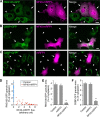RNA granule assembly and disassembly modulated by nuclear factor associated with double-stranded RNA 2 and nuclear factor 45
- PMID: 24920670
- PMCID: PMC4110319
- DOI: 10.1074/jbc.M114.556365
RNA granule assembly and disassembly modulated by nuclear factor associated with double-stranded RNA 2 and nuclear factor 45
Abstract
RNA granules are large messenger ribonucleoprotein complexes that regulate translation and mRNA translocation to control the timing and location of protein synthesis. The regulation of RNA granule assembly and disassembly is a structural basis of translational control, and its disorder is implicated in degenerative disease. Here, we used proteomic analysis to identify proteins associated with RNA granule protein 105 (RNG105)/caprin1, an RNA-binding protein in RNA granules. Among the identified proteins, we focused on nuclear factor (NF) 45 and its binding partner, nuclear factor associated with dsRNA 2 (NFAR2), and we demonstrated that NF45 promotes disassembly of RNA granules, whereas NFAR2 enhances the assembly of RNA granules in cultured cells. The GQSY domain of NFAR2 was required to associate with messenger ribonucleoprotein complexes containing RNG105/caprin1, and it was structurally and functionally related to the low complexity sequence domain of the fused in sarcoma protein, which drives the assembly of RNA granules. Another domain of NFAR2, the DZF domain, was dispensable for association with the RNG105 complex, but it was involved in positive and negative regulation of RNA granule assembly by being phosphorylated at double-stranded RNA-activated kinase sites and by association with NF45, respectively. These results suggest a novel molecular mechanism for the modulation of RNA granule assembly and disassembly by NFAR2, NF45, and phosphorylation at double-stranded RNA-activated kinase PKR sites.
Figures












Similar articles
-
Phosphorylation of the NFAR proteins by the dsRNA-dependent protein kinase PKR constitutes a novel mechanism of translational regulation and cellular defense.Genes Dev. 2010 Dec 1;24(23):2640-53. doi: 10.1101/gad.1965010. Genes Dev. 2010. PMID: 21123651 Free PMC article.
-
NF90 exerts antiviral activity through regulation of PKR phosphorylation and stress granules in infected cells.J Immunol. 2014 Apr 15;192(8):3753-64. doi: 10.4049/jimmunol.1302813. Epub 2014 Mar 12. J Immunol. 2014. PMID: 24623135
-
Stress granules regulate double-stranded RNA-dependent protein kinase activation through a complex containing G3BP1 and Caprin1.mBio. 2015 Mar 17;6(2):e02486. doi: 10.1128/mBio.02486-14. mBio. 2015. PMID: 25784705 Free PMC article.
-
Cataloguing and Selection of mRNAs Localized to Dendrites in Neurons and Regulated by RNA-Binding Proteins in RNA Granules.Biomolecules. 2020 Jan 22;10(2):167. doi: 10.3390/biom10020167. Biomolecules. 2020. PMID: 31978946 Free PMC article. Review.
-
The P Granules of C. elegans: A Genetic Model for the Study of RNA-Protein Condensates.J Mol Biol. 2018 Nov 2;430(23):4702-4710. doi: 10.1016/j.jmb.2018.08.007. Epub 2018 Aug 8. J Mol Biol. 2018. PMID: 30096346 Free PMC article. Review.
Cited by
-
RNA toxicity in non-coding repeat expansion disorders.EMBO J. 2020 Jan 2;39(1):e101112. doi: 10.15252/embj.2018101112. Epub 2019 Nov 13. EMBO J. 2020. PMID: 31721251 Free PMC article. Review.
-
ILF3 prion-like domain regulates gene expression and fear memory under chronic stress.iScience. 2023 Feb 19;26(3):106229. doi: 10.1016/j.isci.2023.106229. eCollection 2023 Mar 17. iScience. 2023. PMID: 36876121 Free PMC article.
-
ILF3 contributes to the establishment of the antiviral type I interferon program.Nucleic Acids Res. 2020 Jan 10;48(1):116-129. doi: 10.1093/nar/gkz1060. Nucleic Acids Res. 2020. PMID: 31701124 Free PMC article.
-
Implications of RNG140 (caprin2)-mediated translational regulation in eye lens differentiation.J Biol Chem. 2020 Oct 30;295(44):15029-15044. doi: 10.1074/jbc.RA120.012715. Epub 2020 Aug 23. J Biol Chem. 2020. PMID: 32839273 Free PMC article.
-
DNA and RNA Binding Proteins: From Motifs to Roles in Cancer.Int J Mol Sci. 2022 Aug 18;23(16):9329. doi: 10.3390/ijms23169329. Int J Mol Sci. 2022. PMID: 36012592 Free PMC article. Review.
References
Publication types
MeSH terms
Substances
LinkOut - more resources
Full Text Sources
Other Literature Sources
Molecular Biology Databases
Miscellaneous

